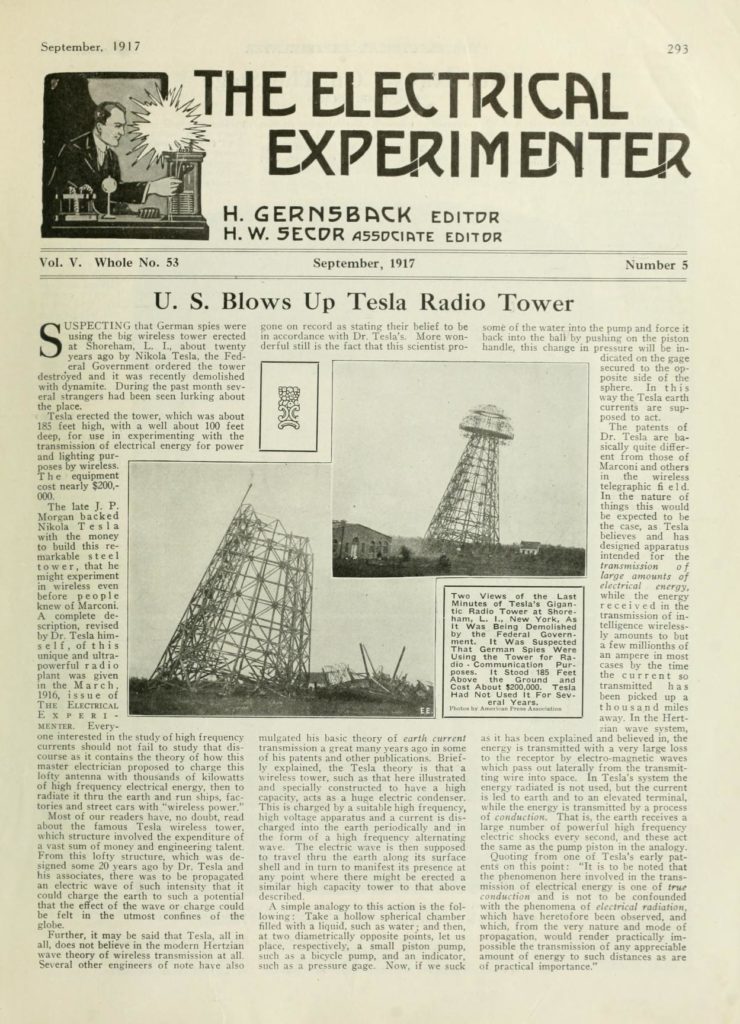Category: Instructor
Event: World Interaction Day hosted by IxDA
Interaction Design Association (IxDA) celebrated World Interaction day on September 24, 2019. World Interaction Day is an annual event hosted at various locations around the globe where designers come together to show how interaction design improves the human condition. Presented in partnership with Adobe, the theme for this year was Trust and Responsibility. I attended this annual event hosted by IxDA in New York.
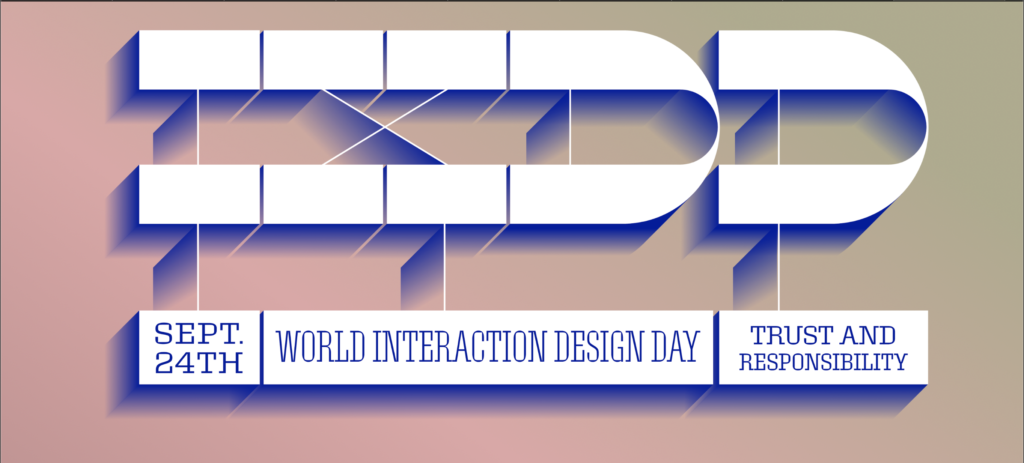
The event kicked off with an introduction by Scott Belsky, the Chief Product Officer at Adobe. He spoke about how good interactions build trust. As designers, we get to influence a crucial part of the user’s experience therefore when we design we need to take responsibility for the interface we create. Users trust the design. Whenever you click a button on a website you expect a result but when you don’t obtain what you expect, you feel deceived. People are more likely to determine the trustworthiness of a website based on its design than reading the website’s privacy policy. How likely are you to close a website because of the number of click baits on the home screen? Have you ever felt cheated when an ad doesn’t look like an ad? Belsky says that as designers our core obligation is to be the voice of the users. Designers should understand their users well especially their needs and concerns and create interfaces that fulfill these needs and concerns.
Mark Webster the Director of Product at Adobe spoke about Trust and Responsibility in Voice Design. The adoption of voice technology in virtual assistants is rapidly growing, especially with the emergence of Alexa and Google Home. Most users of voice enhanced technology claim that voice improves their quality of life( 94%). Although more than half of them (around 49%) find using voice technology unintuitive. This reminded me of the last time I used Alexa and asked her to find the English equivalent of ‘dhania’ and she responded with “I don’t understand”. Did I not articulate enough or was she unable to find what I asked? Webster talked about how designers can play an important role in eliminating problems like these. Voice technology can improve the human lifestyle in many ways. It is an opportunity to allow illiterate people access information, it can help the aged and most of all help people with motor disabilities with their day-to-day activities. The only issue is because voice interaction is so unintuitive it results in uncertainty about all of these things. How is voice going to help people with motor disabilities if the user doesn’t know what the virtual assistant has understood? Voice processing works in three parts – The technology senses speech, the speech is processed according to the various algorithms(natural processing) and then and output is delivered. Current technology has been able to implement the first and last part pretty efficiently but ‘natural processing’ still has a lot of limitations. This is where the role of a designer would be crucial as the designer can understand these limitations, combined with the knowledge of the user’s intent, decide on how to make the experience more intuitive thus enable users to build trust with these technologies.
What do we really mean when we say ethics? Dr. Molly Wright Steenson, Senior Associate Dean for Research in the College of Fine Arts at Carnegie Mellon University elaborates on how designers can incorporate ethics in their design process. Since designers are good at investigating the context of the problem and use human-centric methods to understand the needs of the users and stakeholders, they should be directly involved with data. Framing the design problem is not the only task of the designer but how and what data to collect and use is also a design question. Dr. Steenson emphasizes how the ethics framework should stop looking like a checklist and be a vital part of the product life cycle. This reminded me of the PERCS chart we read earlier which talked about the ethics of fieldwork which according to me can be applied to the design process. Even Costanza-Chock and Sasha’s reading Design Justice talks about how designers should warrant a more equitable distribution of the design’s benefits and burdens and be aware of the cultural and traditional implications of designs.
This talk was followed by Milena Pribic the Advisory Designer of Artificial Intelligence Design at IBM who addressed the issues of ethics in AI. She talked about what it means to build a healthy relationship between two people when one of them is AI. She defined a framework for AI ethics used at IBM that can be incorporated by designers while designing interactions for AI. Trust and transparency are important when it comes to designing for AI. She provides a guideline on how to handle client data and insights to ensure they are protected. They include:
- The purpose of AI is to augment human intelligence
- Data and insights belong to their creator
- New technology, including AI systems, must be transparent and explainable
The event concluded with questions from the audience regarding the topics discussed. This was an eye-opening event for me because I realized as a designer there are numerous factors I should consider when I create my design. Design is not just about solving a problem but also considering its impact. Am I protecting my client/user information? Am I being inclusive of the different communities affected by my design? Am I able to build trust with the users of my design? As a designer have I successfully addressed the needs as well as the concerns of my users? This event made me realize what my responsibility is as a designer and what measures I should take to ensure my designs are trustworthy.
REFERENCES
- Massachusetts Institute of Technology, & Costanza-Chock, S. (2018, June 28). Design Justice: Towards an intersectional feminist framework for design theory and practice. Presented at the Design Research Society Conference 2018. https://doi.org/10.21606/drs.2018.679
- Pribić, M. (2018, September 6). Everyday Ethics for Artificial Intelligence. Retrieved October 15, 2019, from Medium website: https://medium.com/design-ibm/everyday-ethics-for-artificial-intelligence-75e173a9d8e8
- What We Really Mean When We Say “Ethics”—Molly Wright Steenson | Open Transcripts. (n.d.). Retrieved October 11, 2019, from http://opentranscripts.org/transcript/what-we-really-mean-when-we-say-ethics/
- How Good Interaction Design Builds Trust. (2019, September 18). Retrieved October 11, 2019, from Adobe Blog website: https://theblog.adobe.com/how-good-interaction-design-builds-trust/
- IBM’S Principles for Data Trust and Transparency. (2018, May 30). Retrieved October 15, 2019, from THINKPolicy website: https://www.ibm.com/blogs/policy/trust-principles/
- Voice Assistant Statistics & Trends, 2019—UX Survey. (2019, July 22). Retrieved October 11, 2019, from Adobe Blog website: https://theblog.adobe.com/voice-assistant-statistics-trends-2019
IBM Design Thinking Workshop Report
On Oct. 4, 2019, I attended a Design Thinking Workshop held by IBM CIO Design and Pratt Institute for Pratt students. The purpose of this workshop was to introduce the concepts of Design Thinking and conducting some applications on user experience(UX) design.
8 Facilitators from IBM CIO team in this event: Chelsea Calhoun (Content Designer), Dana Chang (Manager), Kelly McGowan (Visual Designer), Shannon Andrea (UX/UI Designer), Soo Yun Kim( Visual/UX Designer), Veronica Moyer (Visual Designer), Youn Lee (UX Designer).
Soo Yun Kim was the principal lecturer, and she started with an ice-breaking activity: attenders were asked to design an alarm clock in 3 minutes and displayed and introduced their works. In the second task, attenders were asked to design an alarm clock for waking people in the morning. This time, when people talked about their designs, they were more confident and spoke with more logic reasoning. This event led us to think about how to design and who we design for, which inspired more innovative outcomes.
Discussed the definition of design with attenders, she declared that design was a discipline that required education, work, and practice to reach proficiency, demanded clarity of vision, blended science, and arts, entailed iteration with real users, and thrived with collaboration. After introducing the IBM company, she illustrated their CIO Mission, “We Make Work Better”: leading with design to drive simplicity and ease of use, engineering the systems that run the business, and innovating to transform the business. Design thinking was the key for them to achieve the mission. She elaborated that design thinking was a framework for approaching problems through collaborative activities. It required a focus on user outcomes, diverse and empowered teams, and restless reinvention. As they mentioned, these principles could guide them to see problems and solutions as an ongoing conversation. The interesting part of these principles was that they use an “infinite” symbol to represent a model Loop, a continuous cycle of observing, reflecting, and making. Repeating this process could help the design team to think about any design problem in multi-direction and through periods.
Design and develop process is always dynamic since the information in this world is transient, and people change their needs every second. Still, the design is key to people’s collective liberation, but most design processes today reproduce inequalities on the matrix of domination. Therefore, the idea of design thinking to collect diversity and repeat the Loop cycle with more participants with intersectionality involved could definitely empower the community, not merely on one single product.
The next part of the workshop was to let attenders practice design thinking through a task. We were offered with the problem to solve with design thinking, “Design a better way for students to find the right classes and professors”. Before we found a partner to start interviewing each other about our experience in choosing classes, we were offered several interview tips:
- Don’t suggest answers to your questions,
- Don’s be afraid of silence,
- Be aware of nonverbal cues,
- Stay on the same path of a question,
- Ask “WHY”.
Those tips extracted from abundant field research experiences with ethics and techniques are very important. To get valuable results from research and interview, it’s essential to concern about the formation, conduct, and communication. Developing the proposal and conducting suitable behaviors are the foundations to build trust with and receive proper feedback from the interviewees.
For the interview, we ideated interview questions, paired up with another person, and interviewed each other in 15 mins. With the interviewing results we got, all attenders were separated into six groups. Each group got one IBM facilitator to help with building up the solution, and our group worked out the procedure with Kelly. First, we needed the empathy map to gather the ideas from the interview into four sections: say, think, does, and feels. During this process, the lecturer explained what made a good empathy map:
- It is based on real research,
- It explores multiple user dimensions,
- It is verified with users or even co-created with them,
- It captures both the positive and the negative.
Based on those guidelines, we noted the top pain points on sticky notes and placed them on board. Then group the similar ones, we found some big ideas, the main concern, and pain points. Next, we used the green and pink dot stickers to vote the most valuable and feasible one. To sort out the solution for that big idea, every group needed to discuss a scenario and storyboard it. Finally, each group should make a presentation to show the result. Our group focused on the pain point that new students hardly had access to class feedbacks from the fellow students, the big idea our group valued most, and made a storyboard of how a new student forum could help through Q&A, while other groups with their big ideas offered solutions like visualizing more professor information and providing the class syllabus and requirements more directly.
This workshop was short for students to finish all the steps and run out a solution, but it gave us an overall idea of how to use design thinking in the application. At the end of this 3-hour workshop, there was the question period. Dana Chang, the design manager reasserted the importance of design thinking not only in design but all through the industry. Also, she talked about the shift of the methods and techniques of research, design and develop, and the excellence of using qualitative research and quantitive research cooperating together with the addition of the new schism based on design thinking. Although those design methods are innovated through time, design thinking is always important. Other designers also shared their experiences in this design industry, and many of them had changed their positions once or twice. It seems that this industry is really dynamic and exuberant, and people are always willing to adjust to new challenges.
Through this workshop, I could understand design thinking in the context of fundamental principles of research, which collects the true needs of the target users. The research is a vital process to learn a certain topic you are working on, both in general and in detail. How to get the information now and in the long run is a problem that leads to the request of ethical jobs. Showing respect, asking for consents, and building trust should be assured if researchers want to protect an interview-friendly environment for both interviewees and interviewers.
Reference
- https://www.ibm.com/design/thinking/page/framework/loop.
- Costanza-Chock Sasha, “Design Justice: towards an intersectional feminist framework for design theory and practice”, 2017.
- PERCS, The Program for Ethnographic Research & Community Studies, “The Ethics of Fieldwork”.
Event Review: The Future of Design and How We Can Prepare
I attended a talk called ‘The Future of Design and How We Can Prepare’ at Pratt Institute School of Information. It was conducted by Lee-Sean Huang, a Design Education Manager at AIGA (American Institute of Graphic Arts). AIGA is a professional membership organization of around 2,500 committed designers who promote a better understanding of design in the government, business and media. They host multiple events that inspire designers across all industries and enhance professional development by providing learning opportunities. The events are usually aimed at community engagement related to the future of design. Huang took us through the concept of AIGA and their strategies with the help of a sideshow. He used engaging videos and structural diagrams to give us a clear understanding of what they stand for. He began by introducing himself, the company’s efforts, their predicted trends and lastly concluded with a question and answer session.
He commenced with topics related to research and community engagement with an emphasis on their ethical guidelines. When it comes to publishing research or creating social content, designers aim to work with the users and not for the users. This brings to life a whole new concept of ‘Co-Design’. Thus, treating users as a part of the design team and using their research with consent, initiating a bond of trust. This directly relates to point numbers twenty-one and twenty-eight of PERCS “The Ethics of Fieldwork” that discusses the idea of informed consent agreements. However, Huang didn’t continue to discuss a valid point raised in the reading, which is how a designer must handle the situation when their critical subject of research changes their mind, leaving their endeavor futile.
Huang also discussed and compared the changing employment structure in the realm of design. He identified the current phase as a design boom and validated it with labor statistics. While fields like graphic design witness a significant drop in employment, software design had a 24% increase. Software design is entirely based on programming and algorithms suggesting immense dependability on machines and databases for design in the future. This raises concerns and links to Nobel’s “Challenging the Algorithms of Oppression” where she talks about critical/privately owned information in the threat of being leaked to the general public. Huang goes back to the olden times and talks about how career growth in the design field was hierarchal – people had to study the basics of design i.ie work their way form the bottom to the top. Whereas, today, people from different backgrounds directly enter the field from anywhere in between.
After discussing the future of design employment, Huang moved on to 7 trends that will possibly shape the future practice of design. These trends aim at enlightening designers about the course design is talking/will take shortly. Most of them have a few aspects that relate to our class discussions. The first one is ‘complex problems’ which urges designers to think in terms of systems- understanding problems in their physical, psychological, social, cultural, technological, and economic spheres. Thus, focusing more on the potential impact of design. This partially relates to Kincheloe and Peter McLaren’s critical theory that is grounded in the awareness of contextual and social belief systems, so insights are based on a full and truthful understanding.
The second trend is ‘curation/aggregation of content’, this works around the idea of information overload. How the emphasis shouldn’t be about making the content but on the flow of content. This links to Rozenwig’s information overload theory where the infrastructure and medium to manage all present and future digital information is questioned. The third trend is ‘Bridging Digital and Physical Experiences’ which is about creating seamless and unified experiences. Experiences should be designed keeping in mind what users do before and after using an app. This will bridge gaps between the online and offline environments.
The fourth trend is ‘core values matter’, this focuses more on a company’s ethos and whether it’s products/services represent the same. It urges businesses to create and understand the value of their social equity. This is relevant when we talk about large technology companies and their responsibility towards users regarding their data. Whether or not they should try and increase their social equity by being transparent and seeking informed user agreements. Zuboff’s theory of the public is reduced to mere ‘bystanders’ is a result of companies lacking a moral based ethos. The fifth trend is ‘Resilient Organizations’ which focuses on how to achieve and maintain a company’s position with an emphasis on innovation. Innovation related to strategic decisions, research data, and business models among the rest.
The sixth trend ‘Making Sense In The Data Economy’ explores five technologies that are instrumental in data collection – sensors, IoT, big data, the cloud, and AI. Although, unlike most of our class discussions this doesn’t take about the ethical/ lack of privacy aspect. He focused more on individual and organization interaction – where organizations aim at improving daily customer operations. And lastly, the seventh trend is ‘anticipating design outcomes’ which is based on research. Huang emphasized on how designers need to justify design decisions through research. Reiterating McGrath’s thought of research always serving as “empirical evidence”. And similar to McGrath’s “generalizability” research strategy, Huang talks about the fundamental generalizable nature of research across a variety of applications and contexts. He concluded this trend stating “designers are problem seekers and not problem solvers”. This in many ways cemented the whole generic aspect of research.
Besides this, Huang also spoke about the ‘six-word story’ technique to communicate thoughts aimed to have a greater impact on users. He emphasized on how designers strive to be concise to leave a more dramatic impression. An interesting example he used of six-word stories is “Time machine reaches future. Nobody there”. This indeed made an impact. The examples were extremely inspiring and makes me think of ways I could use this technique to present unique research facts/insights.
The talk ended with AIGA’s future plans. Huang spoke about their upcoming podcast, elaborating why they decided on this medium to voice their vision. Podcasts usually have an effortless conversational and verbal touch along with being cost-effective and accessible. Post this, there was an open question and answer session. Some students raised questions about the leadership in design while others brought up the generalist v.s specialized future of design. Huang believes that a design generalist would probably be more versatile and fit more design roles in the future. Most of us agreed with this, as to work with technology it’s essential to familiarize ourselves with other design aspects that are points of confluence. Huang seemed extremely approachable and helpful. He was friendly and encouraged discussion. The talk was more participatory rather than him doing all the talking. Overall, this experience was an eye-opener for design as a future discipline and that we should prepare to efficiently acclimatize ourselves to this change.
REFERENCES
Elon University. Program for Ethnographic Research & Community Studies. The ethics of fieldwork module. Retrieved from www.elon.edu/e-web/org/percs/EthicsHumans.xhtml
Noble, Safiya. “Challenging the Algorithms of Oppression.” YouTube, uploaded by PdF (2016).
Kincheloe, Joe L., and Peter McLaren. “Rethinking critical theory and qualitative research.” In Key works in critical pedagogy, pp. 285-326. Brill Sense, 2011.
Rosenzweig, Roy. “Scarcity or abundance? Preserving the past in a digital era.” The American Historical Review 108, no. 3 (2003): 735-762.
Zuboff, Shoshana. “Big other: surveillance capitalism and the prospects of an information civilization.” Journal of Information Technology 30, no. 1 (2015): 75-89.
McGrath, Joseph E. “Methodology matters: Doing research in the behavioral and social sciences.” In Readings in Human–Computer Interaction, pp. 152-169. Morgan Kaufmann, 1995.
Libraries and Information Access in New York State Prisons (Working Title)
by Jay Rosen
For this paper, I will examine the current state of prison libraries and offsite library services across New York State, with an eye towards recommending best practices and identifying critical issues in the provision of prison library services. I will begin with an overview of New York State’s prison libraries as they exist today, reviewing their structures, services offered, and apparent limitations. I will also examine outreach services offered by library systems including New York Public Library’s Correctional Services Department, as well as efforts by grassroots organizations such as Books Through Bars NYC to deliver books and other materials to incarcerated people. I hope to speak with library staff who help coordinate these services, including NYPL Correctional Services staff Emily Jacobson and Sarah Ball, and will also reach out to fellow students in Pratt’s Prison Library Support Network to learn more about their volunteer efforts and their thoughts on these issues.
In examining library services in New York State’s prisons, I will look at the funding structures and bureaucratic and legal hurdles that enable or limit them, and suggest ways that these services might be strengthened going forward. In seeking a theoretical grounding for this paper, I will explore whether Critical Librarianship might usefully inform work being done in prison libraries. I will also seek out research on the relationship between prison library services and recidivism rates, the role of public libraries for individuals re-entering society, and any publicly accessible feedback from incarcerated people on existing prison library services in New York State.
Throughout the course of this paper, I plan to rely on literature review, government information, and actual conversations with local library staff and volunteers working in relevant areas. I anticipate a couple possible challenges. The first is scope. Focusing on prison library services across New York State might prove to be too broad; if this is the case, I will limit my inquiry to prisons libraries in and around New York City. The second is the potential dearth of research on the impact of library services on incarcerated people. If I am unable to find much information on this, I might consider how such research could be successfully designed and carried out in the context of New York State. I will also emphasize research that outlines relationships between higher education programs in prisons (such as the Bard Prison Initiative) and recidivism rates, as well as research concerning the impact of Pell Grants in prisons. In recommending best practices, I will look to the efforts of Scandinavian prison libraries.
Blog Post 1: Person, Place, Thing
by Jay Rosen
I recently spoke with Jennifer Gellmann, Assistant Division Manager of the Society, Sciences, and Technology (SST) division at Brooklyn Public Library’s (BPL) Central Library. Given my interest in adult services and reference librarianship, I was eager to learn about Jennifer’s work and the day-to-day challenges and rewards of her job.
Jennifer began by giving me a brief overview of SST’s scope and collections, and explaining its relationship to the greater Adult Services department at Central Library. SST is staffed by 8-full time “Adult Librarians,” and has a large and diverse physical collection with books on philosophy, psychology, social sciences, science, technology, and industry. SST also has digital collections, special collections containing government publications and legal documents, and a small reference collection.
SST is but one of four divisions making up the Adult Services department at Central Library. Other divisions include “Languages & Literature,” “History, Biography, & Religion,” and “Art & Music.” Related adult-centered divisions include BPL’s Business and Career Center, which offers services for jobseekers and small businesses, the Information Commons, which delivers technology-related programs and services in lieu of a physical collection, and the Brooklyn Collection, a local history archive. BPL’s Central Library is also home to an Adult Learning Center, which provides ESOL classes, test prep, and related educational services to adults. In Jennifer’s view, the various divisions and distinctions among adult service oriented departments are “unnecessarily complicated” and a vestige of prior administrations. For the most part, these departments stand alone, with little inter-departmental communication and collaboration (more on this later).
Jennifer described her role as involving a combination of supervisory, administrative, and public facing duties, with the ratio among these tasks varying depending on particular staffing and library needs. However, she did emphasize that public service is the most significant aspect of her job and the work of her department more generally, with all other responsibilities following from this priority.
Public service duties in SST include working at its reference desk and contributing to virtual chat and email reference services. When I asked about the typical information needs of her patrons, Jennifer told me the “vast majority” of patrons visiting SST are looking for a book on a particular topic. She pushed back on the notion of print being less important in today’s digitally connected age, despite circulation statistics dropping slightly each year.
For the most part, SST is able to successfully meet patron requests, but Jennifer did mention a couple of common issues her department runs into. For one, certain popular books are always in demand to an extent that BPL can’t accommodate. This means patrons often have to place holds and wait several weeks to get materials they need. SST also receives occasional requests for textbooks, but does not purchase them for their collection; as a result, they have to refer patrons to local universities and academic libraries. Despite having one of Central Library’s most expansive physical collections, “you can’t make everybody happy.”
Contrary to many branch libraries that serve fairly defined and specific local communities, Jennifer explained that Central Library serves people from all over Brooklyn. As a result, SST does not serve any one particular demographic. Jennifer emphasized that her work experience varies from branch library service in a couple important ways. For one, there is a great deal of segmentation between different departments at Central Library, with many patrons never stepping foot in the SST division. Because of this, Jennifer’s staff is less familiar with their information needs, which is usually more apparent in smaller branch libraries. In addition, Jennifer explained that branch library staff tend to “wear a lot of hats”, whereas staff at Central Library by and large have a narrower set of responsibilities.
Jennifer was refreshingly honest when describing the challenges of her work. In her view, SST’s primary public service challenge is dealing with the anger and confusion of patrons with undiagnosed and untreated mental illness. “It’s a problem no one has really solved yet,” she told me. Though her staff takes a patient and tolerant approach in these moments, and does their best to regard every request as legitimate, “there’s only so much we can do.” And while SST staff occasionally refers homeless patrons to local service agencies, they choose not to refer mentally ill patrons due to their lack of expertise with mental health issues. Interestingly, BPL hired a full-time social worker a few years ago to help respond to this need, but are currently without one. Until a new social worker is hired, Jennifer and her staff will continue to be seen by some patrons as “de facto social workers,” without the necessary training, expertise, or support. From what I have heard, this appears to be a major unsolved problem for many public-facing library staff around the country.
In further describing the challenges of her job, Jennifer highlighted a general lack of communication between higher administration and the rest of BPL’s staff. I witnessed the same dynamic firsthand during my time at Cleveland Heights Public Library system, and in Jennifer’s opinion this problem plagues most other larger library systems. Though I’m sure it’s easier said than done, I find it both strange and deeply ironic that institutions built to efficiently organize and distribute information suffer from such poor inter-departmental communication.
Jennifer also acknowledged the difficulties of finding and retaining good staff on a limited budget. As she put it, “it’s hard to make a life and have a family in New York City on a particular salary level.” This unfortunate fact this has led to a sharp distinction between “lifers” (Jennifer’s term)— those Jennifer’s age and older who have worked in libraries for decades and live with relative financial stability — and younger staff who are unable or unwilling to commit to the field indefinitely for financial reasons.
Though very frank about the challenges of her position, Jennifer expressed a very clear enthusiasm for her work. She described the main benefits of her job as providing good public service and helping people locate materials that are meaningful to them. Jennifer also expressed contentment with working in “middle management,” citing the mix of public service, committee participation, and administrative roles inherent to her work, as well as the increased “headaches” that seem to come as one moves higher up in library administration.
Significantly, Jennifer told me that the information needs of her patrons have remained relatively stable over time, with the main change being a gradual decline in “reference ready” questions. Erik Bobilin, an Adult Librarian at SST I briefly spoke with, spoke to a more general decline in reference transactions in his experience, likely due to the ease of independently using information technologies. However, both Jennifer and Erik claimed that their division still regularly receives open-ended and more involved research-related reference questions.
When I asked Jennifer what qualities she thinks are needed to succeed in adult services, she emphasized soft skills, including communication skills, the ability to work with a wide range of people, a willingness to answer a variety of different questions, and, above all, patience. This last quality is so important “because the patron doesn’t always know what they want,” and so public-facing staff may need to spend significant time interviewing a patron before unearthing their ultimate question.
Event Review: Museums and AI in the 21st Century
The event taken place at Cooper Hewitt, Smithsonian Design Museum on Sep 16, 2019 mainly discussed the applications of Artificial Intelligence now and future and highlighted the role of museums as making people more self-aware. There were three talks in the event given by three different perspectives (a curator, a computer and a future teller) and a free Q & A session afterwards.
Curator: Andrea Lipps, an associate curator of Contemporary Design, Cooper Hewitt
The talk given by a curator from Cooper Hewitt first discussed the impact of AI on our lives right now. As is known to all that AI could be used in different kinds of fields like education, recreation, medical treatment, marketing automation, etc. AI could analyze large amounts of data in a short period of time and help make quick decisions. The benefits of AI are undoubted and visible. However, the curator also pointed out some questions that could not be ignored:
1.How can we ensure diversity, inclusion, safety and human rights are maintained with AI?
2.What role would AI play in our future?
3.How could museum use AI to represent new things?
There is no right or wrong to these questions and we could interpret the questions from different angles. The curator also provided some frameworks that we could use to think about AI:
1.Is it active or passive? If it is active, do you have a choice? If it is passive, is it being disclosed?
2.Is it being linked to a real-world identity or just used as anonymous ID?
3.Which methods being used when connecting AI with museums?
It’s true that we could only predict the influence and applications of AI in the future but what we should pay attention to right now are our own values and priorities. Because the use of AI is designed by human beings and design is just the externalization of our own desire. “If we use, to achieve our purposes, a mechanical agency with whose operation we cannot efficiently interfere once we have started it… we had better be quite sure that the purpose put into the machine is the purpose which we really desire.” Said Norbert Weiner in 1960.
Computer: Harrison Pim, a Data Scientist from Wellcome Trust
The data scientist who represented a computer talked about his work content, that he used machine learning in dealing with loads of images, texts and collections quickly but not analyzing users or visitors, since AI in current period was parasitic on data. He also pointed out that AI was not designed to replace human beings but as tools to be used by people. So, the main point is how to use the tools to better serve people’s needs. The talk given by “the computer” reminded me of what I read in What is Computer Ethics: we are in a conceptional vacuum and policy vacuum world and we need to reexamine the regulations in the past world, from how to define tech-based concepts to create a relatively neutral algorithm. It is impossible to create something absolutely neutral but by creating diversity, the “fundamental vulnerability” could somewhat be relieved.
Creator: Karen Palmer, a storyteller from the future
The future teller first warned everyone that the technology would take over everything and individuals would find themselves lack privacy or security in the near future if we did nothing. We would be derived of the right of telling our own stories and the world was going to be consist of auto-self surveillance, weaponized technology and biased networks.
She used the example of criminal justice system to confirm us that bias would be the biggest problem in AI applications. An example used to support was the UK police using AI to inform custodial decisions which could be discriminating against the poor. Most assumptions made by AI right now were based on false theory while these assumptions are trend to take over our lives. Thus, she concluded that democratizing AI should be what we fight for in the near future.
What she highlighted was the necessary to turn the information age to an age of perception. “Those who tell the stories rule the world.” What museums should do is to make people more self-aware and create more opportunities to arouse citizens’ insights to social issues.
Q & A session
Q: How to apply machine learning in the field of design?
A: To begin with, the interactions between users and products would be changed by new technologies but the role of designers should not be overshadowed by AI. We could use AI to produce products or test prototypes faster. In a word machine learning should serve us but we should not be slaved by it.
Q: What would justice be like in the future and what is the role of machine learning in it?
A: Neither machine learning or artificial intelligence could answer future justice problems. Those concepts should be determined by human beings but not computer technologies. What would happen in the future is the living space AI help to create and people could better understand culture issues in the museums.
Conclusion
Though we have to admit human’s dominant role in the applications of AI, there are other problems about surveillance, power and constraints that could not be ignored. “In an era of extractivism, the real value of that data is controlled and exploited by the very few at the top of the pyramid.” Said Crawford & Joler. The event did not predict how the regulations could be established but just pointed out museums’ future role in arousing people’s awareness, which I think lack enough support and overly optimistic to some extent. Anyway emphasizing museums’ social responsibility is quite necessary right now and all museum practitioners should be prepared for the transformation of exhibition modes.
Reference
Norbert Weiner (1960), Some Moral and Technical Consequences of Automation;https://www.lesswrong.com/posts/2rWfmahhqASnFcYLr/norbert-wiener-s-paper-some-moral-and-technical-consequences
James H. Moor (1985), What is Computer Ethics? 1-2
Tarleton Gillespie (2014), The Relevance of Algorithms, 191; https://www.microsoft.com/en-us/research/wp-content/uploads/2014/01/Gillespie_2014_The-Relevance-of-Algorithms.pdf
Crawford & Joler (2018), Anatomy of AI system; http://www.anatomyof.ai


Nikola Tesla, Wardenclyffe & The Wireless World System
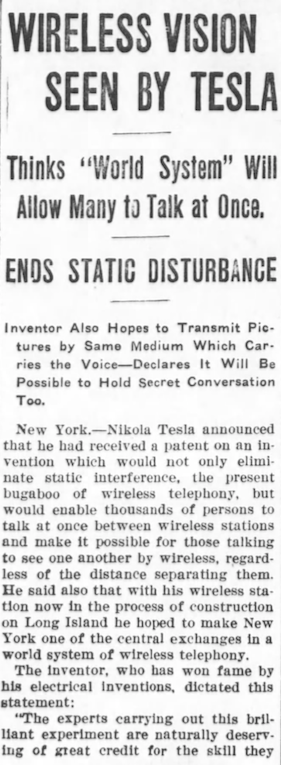
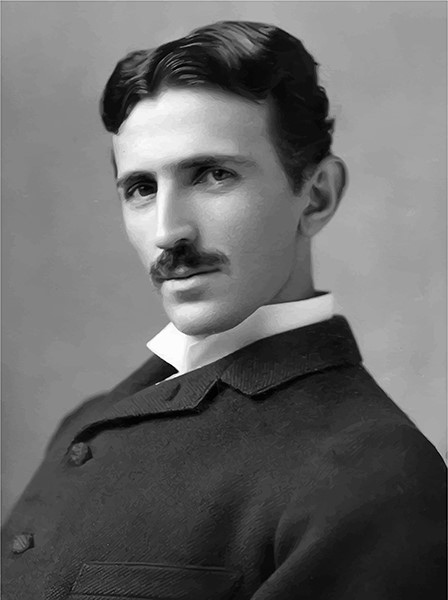
Excerpt from The New York Times
Oct. 3rd 1915
In his lifetime, Nikola Tesla was overshadowed, and even undermined, by his peers in the field we now refer to as STEM. His creations and theories, however, have endured beyond the twentieth century to significantly influence our modern methods of telecommunication, while his legacy of sensational experiments has come to epitomize what it means to be an innovator in the minds of many around the world. Through his ingenuity, and mastery of the alternating current, Tesla was crucial to ushering in the age of electricity. His advances in power transmission revolutionized the public’s accessibility to energy, light and heat, and paved the way for a host of life-altering conveniences we now take for granted.
Though he recognized the significance of his work, and the great technological strides he was making, Tesla never became complacent in his achievements. His AC motors fed into the development of the powerful Tesla coils, which in turn were the catalyst for his breakthroughs in artificial illumination and X-rays. Those experiments would then spurn him on to his loftiest of aspirations: the wireless transmission of information and power.
While this grand goal ultimately eluded Tesla, his total body of work and overall vision of technological progress is remarkable nonetheless. In the same vein as Jules Verne in the generation before him, and George Orwell in the generation after, Nikola Tesla possessed such a prescient mind that he seemed to know the future. To theorize, and nearly implement, a global wireless network over 100 years ago is an astounding feat, and leaves little wonder as to why so many people have been captivated by his accomplishments.
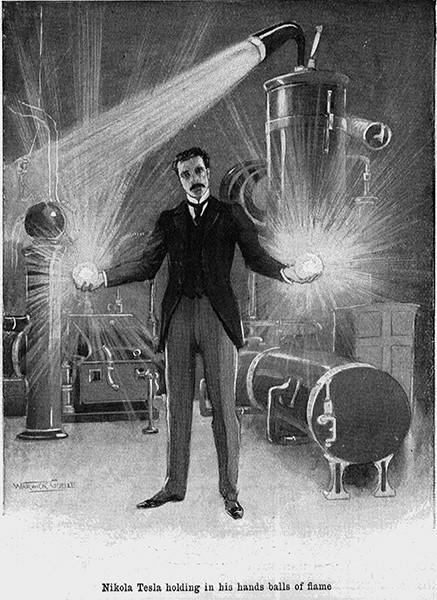
It should come as no surprise that scientific endeavors tend to take place in a laboratory, but what is not as well-known is the fact that Tesla’s sole surviving facility is here in New York. Erected near the Atlantic Ocean because of the proximity to England for transmission tests, Wardenclyffe was designed by prominent architect Stanford White (who is also responsible for the Washington Square Arch) and financed by banker J.P. Morgan. Situated 50 miles East of Manhattan, the brick structure was completed in the early years of the twentieth century.
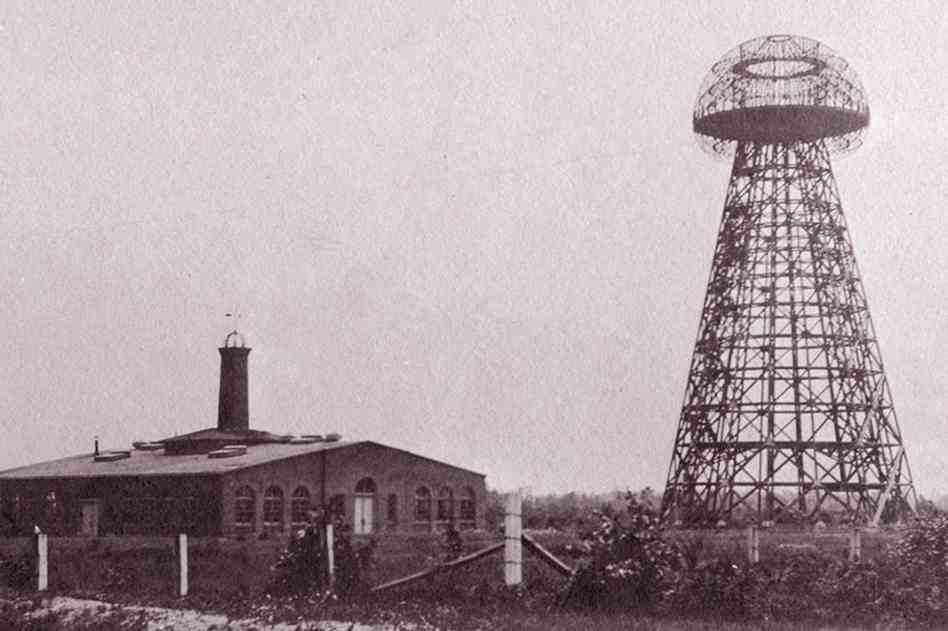
The Tower at Wardenclyffe was a literal apex of Tesla’s imagination and engineering prowess. Though he had achieved success and numerous patents addressing radio wave transmissions, he was not satisfied with mere wireless communication, and became increasingly focused on developing a means of relaying usable electrical power through the atmosphere. This obsession of sorts unfortunately led to Tesla’s professional downfall. Instead of continuing his progress on telecommunications, his affinity for wireless power caused funding to dry up and in only a few short years the laboratory and tower were vacated.
Though Wardenclyffe was abandoned and neglected for much of the previous century, it has been given a second life as the Tesla Science Center in recent years, and the site earned entry into the National Register of Historic Places in 2018. As a not-for-profit organization, the Center’s mission is to serve as both a museum and practical teaching environment. By preserving the laboratory and legacy of Nikola Tesla, while also hosting local scholastic physics competitions, guest lecturers and community events, the Center honors the historical contributions of its namesake as it strives to enrich the education and development of future generations.
Wireless World System
“As soon as completed, it will be possible for a business man in New York to dictate instructions, and have them instantly appear in type at his office in London or elsewhere. He will be able to call up, from his desk, and talk to any telephone subscriber on the globe, without any change whatever in the existing equipment. An inexpensive instrument, not bigger than a watch, will enable its bearer to hear anywhere, on sea or land, music or song, the speech of a political leader, the address of an eminent man of science, or the sermon of an eloquent clergyman, delivered in some other place, however distant. In the same manner any picture, character, drawing or print can be transferred from one to another place. Millions of such instruments can be operated from but one plant of this kind.”
– Nikola Tesla c. 1901
Believing he could tap into the resonant frequencies and conductivity of the Earth itself, Tesla envisioned a system which could relay energy in a myriad of forms around the globe using highly elevated transmission and reception towers. This “cloud” of wireless signals could serve as the conduit for text, images, audio, video and even electrical power for motors or light bulbs, according to his theories. While the funding and feasibility of putting such a network into practice did not materialize before his death in 1943, unfettered access to data and reliable energy is a brass ring we still have not completely reached. Poor wifi reception, drained batteries, dropped calls, broken chargers and network dead-zones are all modern symptoms of the same problem Tesla was attempting to resolve those many decades ago. What thoughts might cross his mind if he were to interact with our latest smart phones? Would he marvel at the quantity of content available? The speed with which he could access it all? Would he be impressed by our “wireless” charging pads or the ability to exchange battery power by simply holding two compatible phones adjacent to each other?
Though the potential of his experimentation was never fully realized, Tesla’s concept of a ‘Wireless World System’ serves both as a rudimentary precursor to our current global networking capabilities, and also as an advancement in technology still worth striving for.
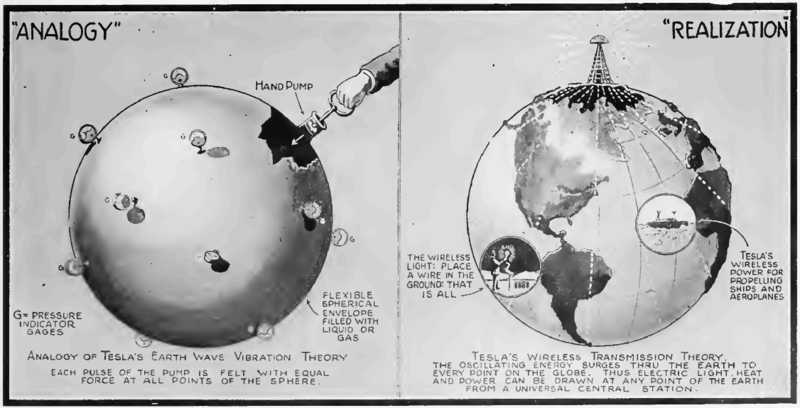
References:
https://www.nytimes.com/1915/10/03/archives/nikola-tesla-sees-a-wireless-vision-thinks-his-world-system-will.html
https://www.smithsonianmag.com/history/the-rise-and-fall-of-nikola-tesla-and-his-tower-11074324/?no-ist
https://archive.org/details/n5electricalexperi05gern/page/293
https://teslasciencecenter.org/
Newest Americans: Activating Archives Through Oral History
Through the historical gates of Barnard College, under the shadow of Riverside Church, and down the stairs of the Milstein Center Library, Columbia University’s Oral History Master of Arts program held the second event in a series of oral history and story-telling workshops. Tim Raphael, co-founder and director of the Newest Americans oral history and story-telling project, presented about the origins and scope of the project. Despite being a talk geared towards historians and story-tellers, there stood out a few interesting connections to preservation and representation in archives and story-telling.
Raphael, a newly appointed Arts, Cultures, and Media Professor at Rutgers University, displayed his theater background with the ease in which he handled a few technical difficulties. Through video clips not cooperating, his laptop having died hours ago, and being emailed the wrong and out-of-order slide presentation, Raphael handled himself well and showed only a slight nervousness at speaking to Ivy League students and professors. Personally, I felt at ease upon overhearing several students discuss their confusion over an assignment, and one students’ phone going off mid-presentation. Ivy League-ers, they’re people too.
A few sharply worded digs at archivists early on brought to mind Michelle Caswell’s impassioned discussion of the “intellectual rift between archival studies scholarship and humanities scholarship” in her article for Reconstructionism (Caswell, 2016, p. 15). Speaking casually with Columbia’s director of OHMA, Amy Starecheski, Raphael uttered the phrases, I’m paraphrasing, “the archives as chambers of death,” and “archives are where no on who’s not an academic dare to tread.” As I wondered if this is what it feels like to be an information professional, to feel peeved when someone speaks down on archives, Raphael began his presentation.
Before introducing the main event, Dr. Starecheski started by acknowledging the land. She acknowledged that Columbia and Barnard sit on the stolen land of the unseated Lenape People, and that indigenous stories are rarely seen in archives. Inspired by the hyper-diverse community of the area, Newest Americans is a multimedia oral history and story-telling project at Rutgers University focused on telling the stories of immigrants and first generation Americans in and around Newark, New Jersey. It works through collaboration between film makers, photographers, artists, historians, journalists, faculty, and students.
It all started when a cardboard box of tapes from the 90s was found in the corner of a library, “and the librarian didn’t even know it was there” mused Raphael. These tapes were found to contain over 120 interviews with people who moved to Newark during the Great Migration between 1916 and 1970. Interviews with people of African heritage and descendents of slaves, the stories inspired Raphael to tell, what he calls, “local narratives with national and global implications.” The stories told are all examples of the preservation of cultural heritage, and the attempt to collect the stories of often ignored Americans. The goal of the format is to, as Raphael explained, “activate the archive” by creating engaging, entertaining, and informational short videos that new dimension to the american story.
Raphael showed one of the first projects produced by Newest Americans: an 8 and a half-minute documentary about current Newark mayor, Ras Baraka, his father, and his grandfather. The two voices heard in We Came and Stayed: Coyt Jones/Ras Baraka, are that of Baraka and his grandfather: Coyt Jones, who was the grandson of a slave and whose interview was one of the over 120 found in a box. Jones was asked over 14 pages of questions for an oral history project organized by the Krueger-Scott Cultural Center in the 90s.
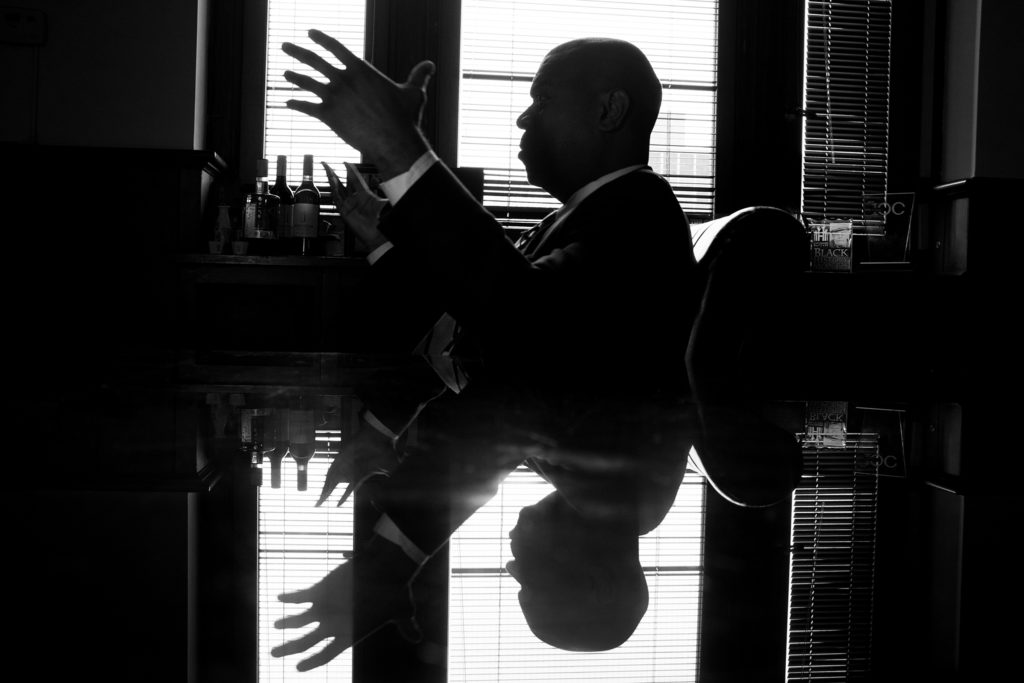
This is a long quote but it perfectly summarizes the documentary: “In his interview, Coyt Jones reflects on his arrival in Newark [in 1927] and the city in which he raised his family. […] Ras Baraka sat down with Marcia Brown to share his own memories of growing up in Newark, and to answer some of the same questions posed to his grandfather twenty years ago. Together these interviews describe how the Great Migration transformed a family and a city (Newest Americans, 2015).” This is an entertaining way to preserve cultural heritage and I can envision a museum exhibit dedicated to the projects inspired by these tapes. In a way, this story is an example of Macdonald’s ‘difficult heritage.’ It is a way for people who lived through the civil rights era and were victims of injustice to further take ownership of their history and identity.
After We Came and Stayed, Newest Americans expanded into stories of people of many different backgrounds and U.S. cities, and recently began projects in Guatemala, Malta, and Lebanon. There was a tense moment towards the end of the question and answer part of the event when Raphael was asked about his role as a storyteller who is a white male and the inherent power imbalance. He appeared a bit shaken and shifted to the importance of story-telling and how much he loves the stories and that with the “access to all these amazing people” how could he not want to tell their stories. He finished his non-answer by stating, “if we only told our own stories, what a f—-ing boring world it would be.” Miriam Posner addressed this issue at the end of her keynote speech . She said, “it’s incumbent upon all of us […] to push for the inclusion of underrepresented communities […] (Posner, 2015). But, as Joan Shwartz noted towards the end of an introduction to two issues of Archival Science, and referencing Verne Harris, “It is important […] not to romanticize the marginalized, or feel elated for saving them from historical oblivion” (Schwartz, 2002, p. 17). There is a trend among archivists to collect previously unheard or underrepresented voices and stories, but inherent bias exists even if unintentional. For example, Indigenous Cataloging is the process for organizing information of indigenous people, but to have a separate phrase possibly further marginalizes the community. However, these stories need to be preserved and told as well, even if they are told by an outsider. It’s a difficult issue with a lot of ongoing discussion.
Representation and preservation in archives and oral history will continue to focus more on the underrepresented voice and I think the best thing to do is, like Dr. Starecheski, acknowledge that we are on stolen land and acknowledge the power imbalance of a white male producing a documentary about the those underrepresented voices. Newest Americans is an admirable example of activating archives to bring stories alive.
Heidi Klise
Sources:
- Caswell, Michelle. (2016). “The Archive’ is Not An Archives: Acknowledging the Intellectual Contributions of Archival Studies” Reconstruction 16(1). http://reconstruction.eserver.org/Issues/161/Caswell.shtml.
- Macdonald, Sharon. (2015). “Is ‘difficult heritage’ still difficult?” Museum International 67: 6–22
- Newest Americans. (Summer 2015). “We Came and Stayed: Coyt Jones/Ras Baraka.” Retrieved from http://newestamericans.com/wecameandstayed-baraka/#
- Posner, Miriam (2016). What’s next: The radical, unrealized potential of digial humanities. Keystone DH conference, University of Pennsylvania, July 22, 2015. http://miriamposner.com/blog/whats-next-the-radical-unrealized-potential-of-digitalhumanities/
- Schwartz, Joan M. & Terry Cook. (2002). “Archives, records, and power: the making of modern memory,” Archival Science 2: 1–19.
Suhair Khan, Street Museum of Art, Little Robots Friends
Person: Suhair Khan
My person is Suhair Khan, project manager at Google Arts & Culture. A click on the link will immediately pull up the world’s array of art collections, stories, and cultural sites onto your screen. You can check out the local Guggenheim Museum to see what exhibitions are happening or hop over to Vienna to see your favorite painting of ‘The Kiss.’ If you’re feeling adventurous, you can use one of Google’s VR tools to stroll down the murky paths of the Catacombs of San Gennaro in Naples and discover a new collection of mosaics. The beauty of this platform is everything is up to the viewer to decide where they want to go, what they would like to see, and how long they want to be there for. And the best part? This viewing experience is free and meant to be enjoyed in the comfort of one’s home (or in my case, a tiny coffee shop in Greenwich Village).
So what is Google Art and Culture? Simply put, it is a platform launched in 2011 to “provide access to art and culture to everyone and everywhere” (Gajardo & Lau, 2017). Google Art and Culture has kept this mission true. So far, Suhair and her team of engineers have partnered with over 1200 non-profit cultural institutions, galleries, and artists across 70 countries to share, preserve, and present some of the most beautiful artworks and curated stories online.
Suhair is no stranger to multicultural experiences. She grew up in Milan, London, and South Asia and have led projects in the UK, Australia, Indonesia, and Korea. Her mission is to have art and culture accessible to people who can’t travel and “make sure distance and culture doesn’t get in the way of resources and sharing” (Appleby, 2018). This is what technology has allowed us to do: break down the barriers and show art no longer needs to be confined to a physical space but can be made accessible anywhere online. Suhair is reconstructing the way people engage with art by making the experience easier and less intimidating. Instead of traveling to a particular place, the artwork is brought to the viewer. This reminds me of the ‘armchair traveler’ when early photographers would send souvenir photo albums to loved ones back home so they can feel like they were visiting these faraway places without leaving their seat. Technology has allowed us to revitalize the role of a digital ‘armchair traveler’ by making the experiences even more realistic and interactive.
So how can we relate Suhair’s work to the information field? First, Google Art and Culture is showing us a way we can present digitized information meaningfully by “creating networks of connections with context” (Appleby, 2018). We can see this with museum curators’ taking the role of digital storytellers as they now need to consider writing stories for audiences outside of the typical museum-goer realm. Second, we can take note of Google Art and Culture’s broad ways of searching for information. Categorizing artworks by color, popular topics, place, time, historical movement, etc., can inspire us to think outside of our usual groupings and be more ambitious in the pathways we create. Third, a look into Google’s features such as shared birthdays or their famous art selfie app that matches viewer’s face with an artwork provides more intimate and personal ways of engagement that IXD professionals can consider. Finally, the biggest takeaway is the multidisciplinary approach to sharing information. By collaborating with institutions and including tools that compare artworks from various cultures, the information no longer exists as a single narrative in support of one view but is transformed into a collection of narratives in support of cultures around the world. Thereby, viewers are able to get a well-rounded understanding of society and adopt a different cultural perspective.
Place: The Street Museum of Art
I decided to take a more unusual and unconventional route by picking The Street Museum of Art (SMoA) as my place of interest. I would say this is unusual than the rest because SMoA isn’t actually a physical museum, but it is an international, public art project that takes their exhibitions onto the streets and uses the city’s urban environment as their canvas. So far, the exhibitions have been held in New York, London, and Montreal. A look on SMoA’s website reveals their projects have transformed city streets into gallery walls where “admission is always free and the hours are limitless” (“The Street Museum of Art”, n.d.).
‘In Plain Sight’ is an exhibition held in Williamsburg, Brooklyn and features the works of eleven artists “to encourage visitors to rediscovery this city through a street artist’s perspective…. And imagine the artists on their search for the ideal urban canvas” (“In Plain Sight,” n.d.). As mentioned, most of the artworks are hidden or have been cleverly positioned so the viewer would pay attention to sites that are usually ignored and thereby, ‘rediscover’ the urban city. This won’t apply to me as much as I have never been to Williamsburg before. With nothing but a digital Google map, I took the subway to Williamsburg on a sunny Friday afternoon to embark on my urban scavenger hunt.
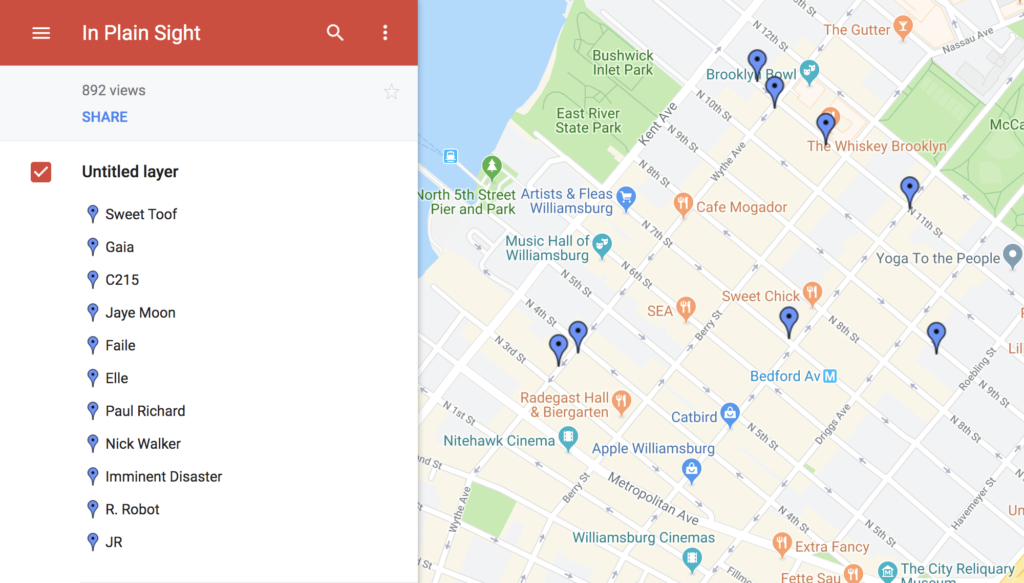
While searching for these artworks, it made me think about some of the topics discussed in class, such as the concepts of permeability and permanence. What happens when these places don’t exist anymore, will the artworks still be archived? How will it be archived – through photographs snapped and shared? I was only able to find two out of eight artworks and gave up on the last three. It may have been partly my fault, as I chose to go with the exhibition from 2012. However, this exhibition made me also think about the art world- how does this experience differ from an exhibition at a museum or gallery setting? In my opinion, the biggest difference was that this urban museum experience became much more personalized. I wasn’t confined to a physical space, I didn’t feel intimidated, and I loved how customizable the guide was. I could listen to music, pause the exhibition and grab a bite to eat, or even complete it over a span of a few weeks. It was also nice to know that my exhibition journey is unique in the sense that there was no specific path given to see the artworks, while museum settings usually give viewers a direct path to follow.
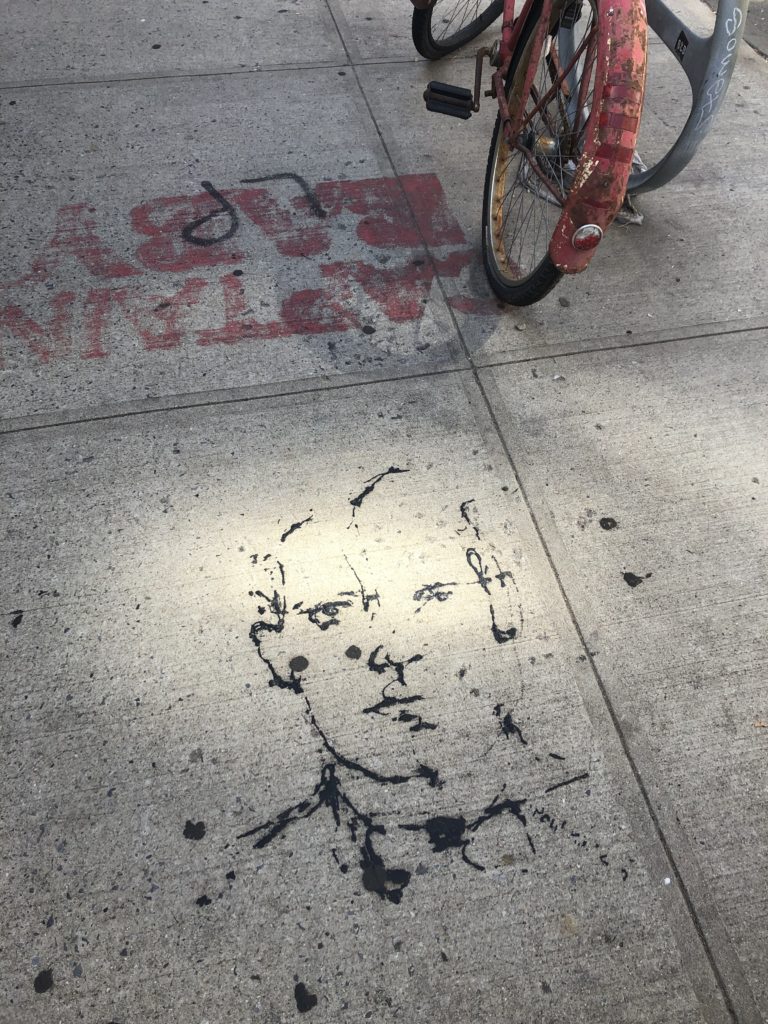
Photo: Janet Liu 2019 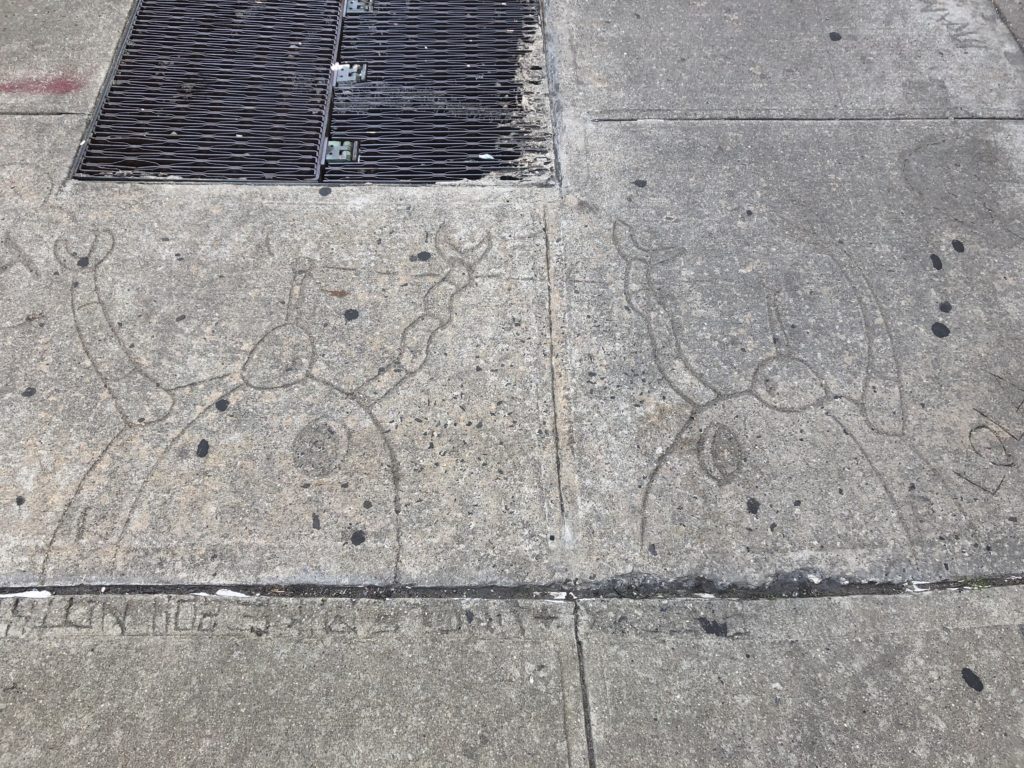
This exhibition also varies greatly from the online ‘In Plain Sight’ on Google Art and Culture. Instead of having everything presented at once on a single platform, SMoA was completely opposite: I had to physically go out and search for all these places myself. Unlike the ‘armchair traveler’ experience that Google Art and Culture provides, SMoA builds upon the ‘in situ’ concept of experiencing the art at its original place. Even though most of the artworks are no longer on view, I would say art in situ becomes more of a valuable experience because I had to physically travel and search for the places. Not knowing what to expect, then being incredibly amazed to find the artwork became a much more memorable, emotional, and personal experience than it would have been seeing it as a digital exhibition.
Thing: Little Robot Friends
I chose the Little Robot Friends (LRF) for my thing. I was searching for fun gift ideas for my nephew when these little tiny adorable creatures caught my attention. Hours later, I found myself still watching their YouTube videos and I ended up almost buying a robot myself.
LRF are programmable, customizable robots that teach kids aged seven or higher how to code. For $49.99, you can purchase a DIY kit or already assembled kit, which also comes with its own coding software filled with open-source-code to program new robot behaviors.
“They can sense the amount of light in a room, they can hear with a small integrated microphone, they can detect your touch and they can also communicate with other Little Robot Friends using infrared light (like your TV remote). They have two RGB LED eyes and a 250mW speaker for expressing their current mood. The brain is an 8-bit 32K microcontroller that provides a lot of space for coding behaviours and storing memories.”
(“Little Robot Friends,” 2016)
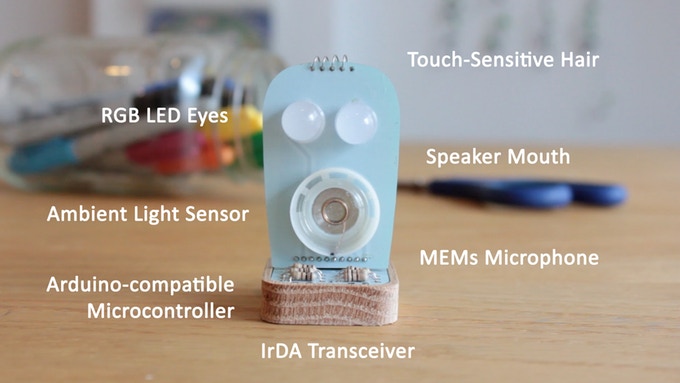
This project is similar to Google Art and Culture and SMoA because of the flexibility of customization for its users. For instance, you are welcome to alter LRF’s personality. I would say LRF is able to create an even more engaging experience than the rest because of the emotional connect. They are robots that are personalized, tangible, meant to be held in one’s hand that can elicit empathy with the robots, and empathy with coding.
“Each interaction with your Little Robot Friend is stored as a memory, and changes how it will behave over time. We are working hard to make this a profound experience, one that can surprise you and make you smile as you watch your Friend grow up.”
(“Little Robot Friends,” 2016)
This makes me think of our previous discussions of provenance, and the idea of treating archives as objects. If we are able to adopt this view and see archives as tangible, living objects such as the little robot friends, then perhaps we will be more mindful and remember that our interaction with the objects will also affect its context and memory.
References:
Appleby, E. (Producer). (2018, May 03). Episode 33: The Art of Connectivity: Suhair Khan from Google Arts & Culture. [Audio podcast]. Retrieved from http://sotapodcast.com/episodes/33
Gajardo, T., & Lau, Y. (2017). The Woman Who is Bringing Museums & Cultural Sites from All Over the World to your fingertips. The Artling. Retrieved from https://theartling.com/en/artzine/interview-head-google-arts-culture-suhair-khan/
In Plain Sight. (n.d.). The Street Museum of Art. Retrieved from http://www.streetmuseumofart.org/in-plain-sight-1
Little Robot Friends. (2016). Aesthetic Studio. Retrieved from https://www.kickstarter.com/projects/aesthetec/little-robot-friends
The Street Museum of art. (n.d.). The Street Museum of Art. Retrieved from http://www.streetmuseumofart.org/about
